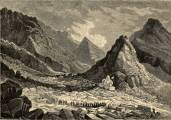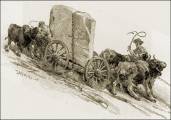


Excerpts From
Construction Materials in
Cloud County, Kansas
Geological Survey Circular 88
By Laurence P. Buck, Richard Van Horn, and Robert G. Young
Prepared in cooperation with the State Highway Commission
of Kansas.
Prepared as part of a program of the Department of the Interior for Development
of the Missouri River Basin.
Washington, D. C., January 1951.
Purpose of the Investigation
The State Highway Commission of Kansas and the United States Geological Survey are cooperating in a State-wide inventory of construction materials. A field party composed of members of the United States Geological Survey investigated sources of engineering construction materials in Cloud County, Kansas, during the summer of 1948. This report of the investigation is a contribution to the geologic mapping and investigation of mineral resources being made in the Missouri River Basin.1 The primary objective of the investigation was to collect all data pertaining to the geologic materials which would be useful in engineering projects.
-
Figure 1. Index map of Kansas showing areas covered by this report and by other construction materials investigations.

Geography of the Area
Area covered by the investigation: Cloud County is in the second tier of Kansas counties south of the Nebraska border and in the eighth tier east of the Colorado border (See Fig 1.) It comprises 20 townships and covers an area of about 720 square miles. The county is bounded by parallels 39° 18' and 39° 39' north latitude and meridians 97° 22' and 97° 56' west longitude.
Topography: Cloud County lies in the eastern part of the Plains Border division of the great plains physiographic province, a submaturely to maturely dissected plateau region.2 The land surface in Cloud County has been dissected to a rolling topography of moderate relief. A conspicuous topographic feature in the northern part of the county is the broad, flat valley of the Republican River, part of which is more than 3 miles wide. The valley of the Solomon River, which crosses the southwestern corner of the county, has a flat floor more than 2 miles wide. These valleys are about 200 feet below the undulating upland and their valley walls are moderately steep. Valleys cut into the unconsolidated sediments in the divide area between the two rivers are shallow with gently sloping walls. Areas between the upland valley are gently rolling.
Roads and Railroads: Two transcontinental highways cross the county. U.S. 24, a major east-west highway with a bituminous-mat surface, crosses the southern part of the county. U.S. 81, a major north-south highway, crosses the central part of the county. His highway is surfaced with concrete from the southern boundary to a point two miles north of Concordia. The remaining part of the road in the county is surfaced with bituminous-mat.
Kansas Highway No. 9 is a bituminous-mat road from Clyde to Concordia and is metaled with gravel in the western part of the county. Kansas Highway No. 28, from Concordia through Jamestown, is a bituminous-mat road. Most of the roads maintained by the county are metaled with materials available locally, whereas most of the roads maintained by the townships are graded earth roads. The railroads shown on plate 1 are all branch lines. No rock quarried locally is used as ballast on any of the railroads in Cloud County.
-
Figure 4. Outcropping stratigraphic units in Cloud County, Kansas, and their construction materials.

Stratigraphic Sources and Performance
Characteristics
(Note: Only the section on "Structural
Stone" will be included here.)
Structural Stone
Engineering and Geologic Characteristics: Structural stone, as defined in this report, is any hard, dense rock materials that can be quarried and cut to the desired size and shape. Materials fulfilling these requirements occur in the Dakota sandstone and the Greenhorn limestone in Cloud County.
Stratigraphic Sources and Performance Characteristics
(1) Dakota Sandstone: The Dakota sandstone is used as structural stone, to a limited extent, in Cloud County and other counties in which the formation outcrops. The quartzitic and quartzitelike phases of the formation are probably entirely acceptable as structural stone; the iron-cemented and loosely cemented sandstones are probably not acceptable, although the iron-cemented sandstone has been used in some buildings in the county. The amount of quartzitic and quartzitelike sandstone now know in Cloud County is quite limited. Intensive exploration of the outcrop area.may yield additional sources.
(2) Greenhorn Limestone: Two limestone beds in the Greenhorn limestone have been used in Cloud County and adjacent counties as structural stone. The "Fencepost" limestone bed at the top of the Pfeifershale member of the Greenhorn is used extensively throughout a wide area in northcentral Kansas, even to a considerable distance from the area of outcrop. A few buildings constructed of "Fencepost" limestone were observed in western Cloud County. The area of outcrop of this bed is mainly in T. 7 S., R. 5 W., where small outcrops were found in section 7, 13, 14, and 24. It is possible that test pitting elsewhere in this township might reveal other sources of this stone.
The "Shellrock" limestone bed at the top of the Jetmore chalk member of the Greenhorn limestone has been extensively quarried and used in Cloud County for structural stone; so many quarries have been opened in this bed that only a few of them have been mapped on plate 1. Additional quarries could be opened at any convenient site in the area of outcrop. Field observation indicates that this limestone is suitable as a structural stone in this area. Structures built of it stand up very well in the relatively dry climate of northcentral Kansas. A church in the SW 1/4 SW 1/4 sec. 18, T. 8 W., R. 3 W. was built of the "Shellrock" limestone in 1880. The rough-hewn stone has weathered well and there is no indication of serious deterioration of the stone itself, although mortar has come out from between blocks in many places necessitating tuck pointing. Other old buildings were observed in which the stone was pitted by weathering but otherwise little affected.
The "Shellrock" limestone bed has also been used in the construction of small bridges, culverts, and retaining walls for bridge approaches or terraces. The rock used in the arches of several old stone bridges is well preserved. However, in many bridges, culverts, and retaining walls where the rock is subjected to surface-water run-off or ground-water seepage, the more highly fossiliferous blocks have been split by freeze-and-thaw action along the surfaces of the fossil shells. Under these conditions, the "Shellrock" limestone is not entirely satisfactory and care should be used to select only the most massive and least fossiliferous stone available.
1 Construction Materials in Cloud County, Kansas, 1951, page 1, footnote 1: Missouri River Basin, conservation control, and use of water resources: 78th Cong., 2d sess., S. doc. 191, 1944.
2 Ibid., page 1, footnote 2: Frye, J. C., The High Plains Surface in Kansas, Kansas Acad. Sci. Trans., vol. 49, no. 1, pp. 76, 81-81, June 1946.
Commercial use of material within this site is strictly prohibited. It is not to be captured, reworked, and placed inside another web site ©. All rights reserved. Peggy B. and George (Pat) Perazzo.